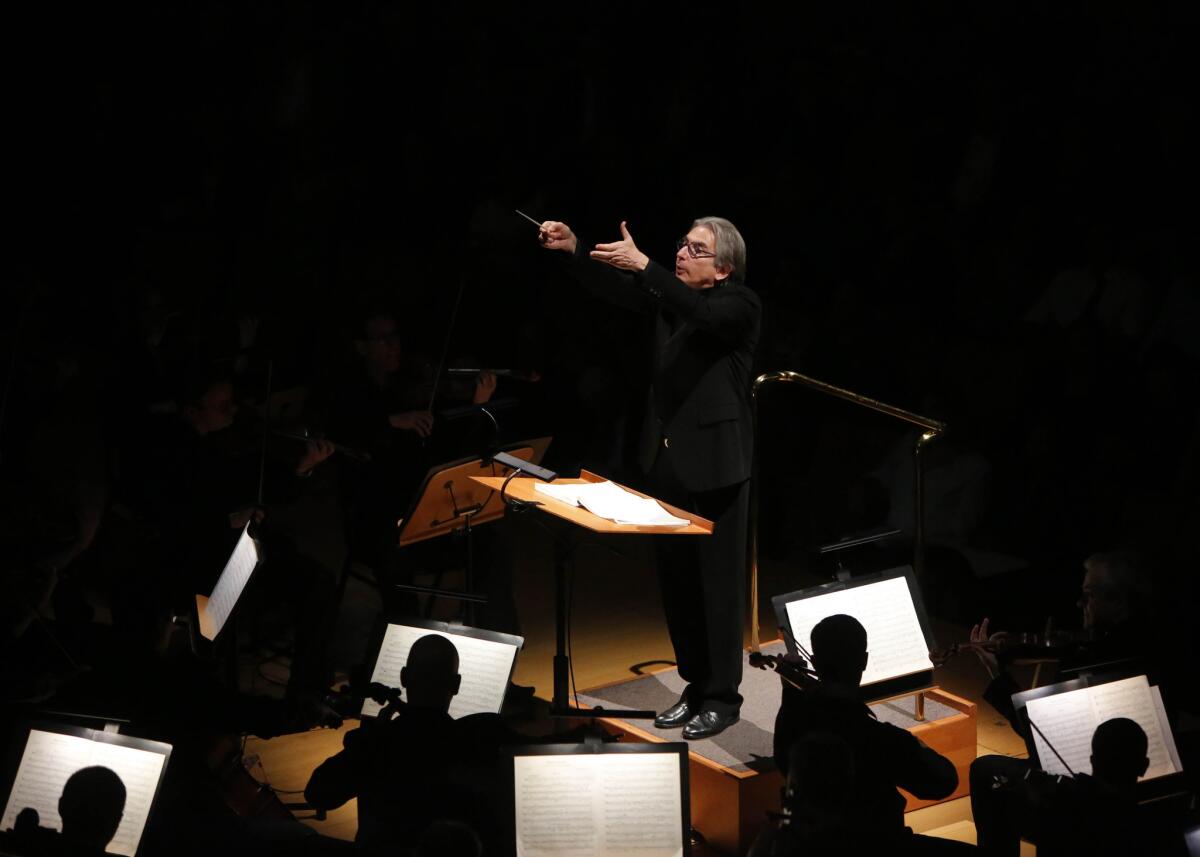Review: L.A. Phil gets theatrical with Beethovenâs Missa Solemnis

Beethovenâs massive Missa Solemnis, which the composer considered his greatest work, is not a Mass meant for church. It is too ecstatic to be simply solemn.
Ultimately, it is a mysterious Mass. Does the score reveal a skeptical, long-suffering composer in his last years resolving doubt, as some scholars have suggested? Or is the real subject not God but Beethoven, a revelation of the wonder of his genius?
Many major Beethoven conductors simply avoid the Missa Solemnis, not knowing what to make of it. Others obsess over it. Michael Tilson Thomas belongs to the obsessive class. He had long proposed a Missa Solemnis solution treating Beethovenâs Mass as physical mass, performing it as a combination of theater piece and installation art. That is what he finally accomplished Friday night with the Los Angeles Philharmonic at Walt Disney Concert Hall.
This vision well suited the orchestraâs new âin/SIGHTâ series, which explores theatrical and new media ways of presenting concerts. The Missa Solemnis, moreover, began the L.A. Philâs âMTT@70â celebration. Tilson Thomas, who was born and raised in L.A., turned 70 last month and will return to Disney in March conducting the London Symphony Orchestra.
Entailing video, costume, lighting and set design, along with stage direction handled by an eight-member creative crew, Tilson Thomasâ ambitious Missa invention is a co-production with the San Francisco Symphony, which will mount it later this season as part of yet another MTT celebration. This year marks Tilson Thomasâ 20th anniversary as its music director.
In the grandest sense, this Missa Solemnis, with all its attendant baggage, is a kind of mission statement for MTT. He sets out to unpack a complicated artistic and musical construct, to reveal its workings and to treat it as a large-scale act of discovery.
On one level he succeeded brilliantly. He led an urgent performance, compelling in its revelation of Beethoven the adventurer, the maverick, the visionary â which is to say, Tilson Thomas got to the essence of Beethoven. But then there was everything else.
A doctored Disney Hall was meant to become a cathedral. A video screen shaped like ragged, torn paper was suspended over the Disney organ pipes, on which was presented abstract churchly imagery to set the scene.
The four vocal soloists, garbed in stylish and coordinated gray suits and dresses, initially wandered aimlessly onto the stage and a platform behind the orchestra. They were like visitors taking in Gothic architectural surroundings, not yet knowing what is in store. A startling burst of blinding light, like an explosion, was the wake-up call announcing the opening Kyrie.
The Los Angeles Master Chorale was divided into a large seated ensemble and a 20-member, more mobile group. Boys from the Los Angeles Childrenâs Chorus came running in during the Gloria, adding exuberance. James Darrah was the director. He followed what he described as a large spreadsheet on which Tilson Thomas had mapped out the action.
Finn Rossâ video imagery included gusts of alphabet letters that occasionally congealed into snippets of the traditional Latin Mass text, a banal depiction of order out of chaos. In the Credo, there were animated Etch-a-Sketch-style renderings of Jesus, accompanied by shooting stars. In the Agnus Dei, a cry for peace in the time of military threat, the video turned to predictable candles. David Finnâs lighting design put the orchestra in pools of glowing colors.
Visually and theatrically, little was achieved. Often, the conventionality of the movement and video imagery served to undercut Tilson Thomasâ musical approach, which emphasized Beethoven breaking the bounds of musical and liturgical convention in almost every possible way.
Tilson Thomas emphasized transparent orchestral textures. He maintained a subtle, fluid approach to rhythm, illuminating Beethovenâs flowing syncopations as if precursors to jazz and John Adams. He used the Disney acoustics to great advantage, with varied placements of singers and instrumentalists. He conducted with lightening speed.
The four soloists â soprano JoĂŠlle Harvey, mezzo-soprano Tamara Mumford, tenor Brandon Jovanovich and bass-baritone Luca Pisaroni â were sensational. They were required to memorize their parts as well as their complicated traffic patterns. Their movement often looked like purposeless movement, which was not to theatrical advantage.
Nevertheless, their theatrical involvement had an invaluable benefit. Their added commitment made them able to follow Beethovenâs complex entries and Tilson Thomasâ nearly unsingable tempos thrillingly. Having boys running amok may be a clichĂŠ in opera stagings, but again there was the advantage of irresistible excitement. The Master Chorale exuded power.
Tilson Thomas also had concertmaster Martin Chalifour memorize his alluring long solo in the Benedictus. The violinist stood on the rear stage like a soloist in a concerto while singers watched in awe, as if a statue of a saint can come to miraculous life. Beethovenâs miracle was the melody, and, as happened more than once in the evening, a stunning performance became dependent on a precious theatrical effect.
Twitter: @markswed
More to Read
The biggest entertainment stories
Get our big stories about Hollywood, film, television, music, arts, culture and more right in your inbox as soon as they publish.
You may occasionally receive promotional content from the Los Angeles Times.











